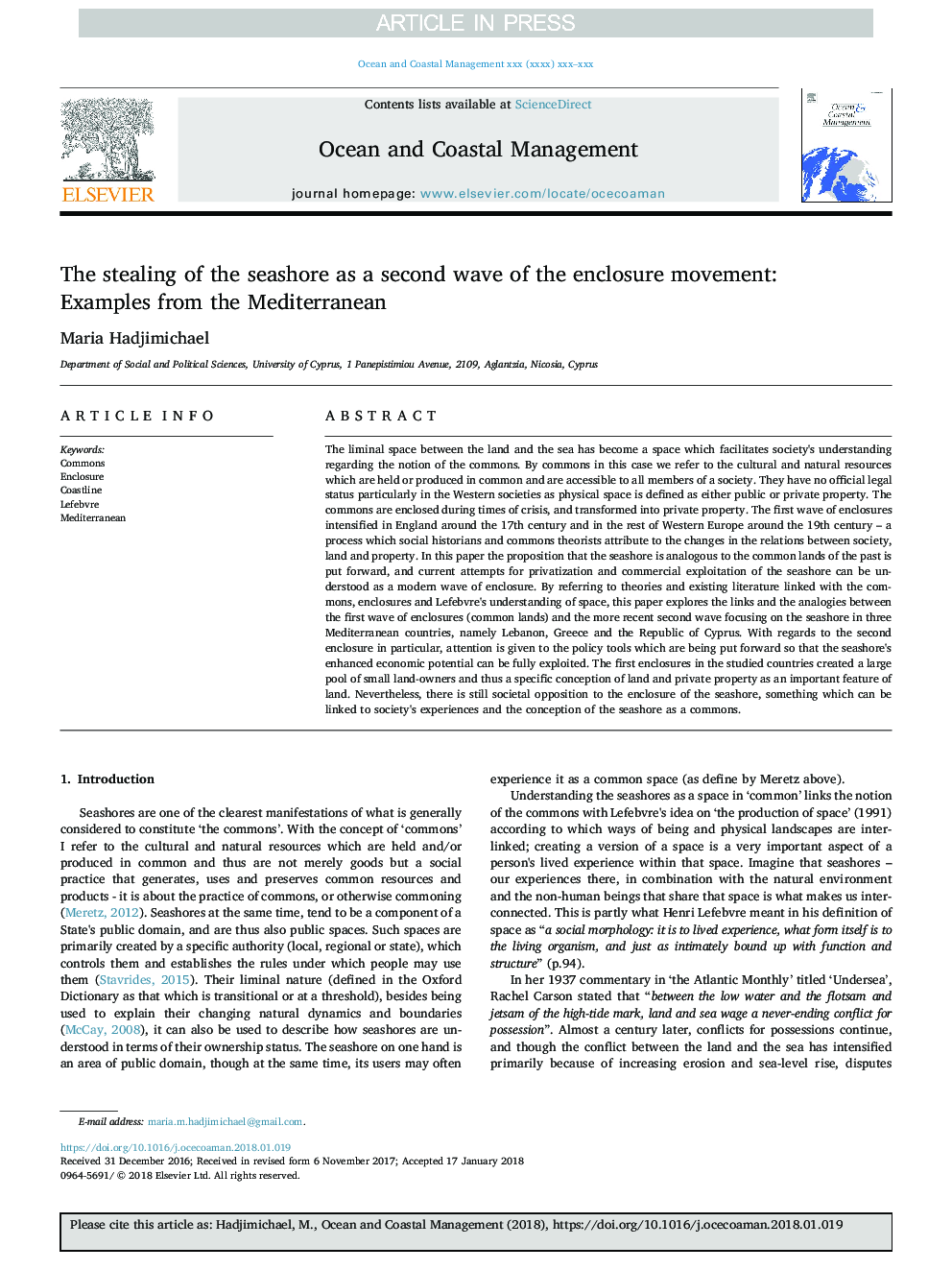| کد مقاله | کد نشریه | سال انتشار | مقاله انگلیسی | نسخه تمام متن |
|---|---|---|---|---|
| 8060591 | 1520467 | 2018 | 7 صفحه PDF | دانلود رایگان |
عنوان انگلیسی مقاله ISI
The stealing of the seashore as a second wave of the enclosure movement: Examples from the Mediterranean
ترجمه فارسی عنوان
سرقت ساحل به عنوان موج دوم جنبش محوطه: نمونه هایی از مدیترانه
دانلود مقاله + سفارش ترجمه
دانلود مقاله ISI انگلیسی
رایگان برای ایرانیان
کلمات کلیدی
مشترک، محفظه، خط ساحلی، لوفور، مدیترانه،
ترجمه چکیده
فضای محدود بین سرزمین و دریا به فضا تبدیل شده است که فهم جامعه را درمورد مفهوم مشترکات به اشتراک می گذارد. به طور معمول در این مورد ما به منابع فرهنگی و طبیعی اشاره می کنیم که به طور مشترک برگزار می شوند یا تولید می شوند و برای همه اعضای یک جامعه قابل دسترس هستند. آنها به طور خاص در جوامع غربی دارای وضعیت حقوقی رسمی نیستند، زیرا فضای فیزیکی به عنوان مالکیت عمومی یا خصوصی تعریف می شود. مشترکین در طول بحران ها محصور شده و به مالکیت خصوصی تبدیل شده اند. موج اول محوطه در انگلستان در حدود قرن 17 و در بقیه اروپای غربی در حدود قرن نوزدهم تشدید شد - فرایندی که مورخان اجتماعی و نظریه پردازان رایج به تغییرات روابط بین جامعه، زمین و اموال مربوط می شوند. در این مقاله گزاره ای مبنی بر اینکه ساحلی مشابه با سرزمین های مشترک گذشته است، تلاش های جاری برای خصوصی سازی و بهره برداری تجاری از ساحل را می توان به عنوان موج مدرن محوطه در نظر گرفت. این مقاله با اشاره به نظریه ها و ادبیات موجود در ارتباط با مفاهیم، محوطه ها و درک فضای لوفوب از فضا، این مقاله پیوندها و تحلیل های بین موج اول محوطه ها (زمین های مشترک) را بررسی می کند و اخیرا موج دوم با تمرکز بر ساحل در سه مدیترانه کشورهایی مانند لبنان، یونان و جمهوری قبرس. با توجه به محفظه دوم به طور خاص، توجه به ابزارهای سیاست گذاری شده ارائه می شود، به گونه ای که به طور بالقوه توان بالقوه اقتصادی ساحلی به طور کامل مورد بهره برداری قرار گیرد. اولین محفظه ها در کشورهای مورد مطالعه یک حوضه بزرگ صاحبان زمین های کوچک ایجاد کرده و بنابراین یک مفهوم خاص از مالکیت زمین و مالکیت به عنوان یک ویژگی مهم زمین. با این وجود، مخالفت اجتماعی با محاصره ساحلی هنوز وجود دارد، چیزی که با تجارب جامعه و درک دریای خزر به عنوان یک رایج در ارتباط است.
موضوعات مرتبط
مهندسی و علوم پایه
علوم زمین و سیارات
اقیانوس شناسی
چکیده انگلیسی
The liminal space between the land and the sea has become a space which facilitates society's understanding regarding the notion of the commons. By commons in this case we refer to the cultural and natural resources which are held or produced in common and are accessible to all members of a society. They have no official legal status particularly in the Western societies as physical space is defined as either public or private property. The commons are enclosed during times of crisis, and transformed into private property. The first wave of enclosures intensified in England around the 17th century and in the rest of Western Europe around the 19th century - a process which social historians and commons theorists attribute to the changes in the relations between society, land and property. In this paper the proposition that the seashore is analogous to the common lands of the past is put forward, and current attempts for privatization and commercial exploitation of the seashore can be understood as a modern wave of enclosure. By referring to theories and existing literature linked with the commons, enclosures and Lefebvre's understanding of space, this paper explores the links and the analogies between the first wave of enclosures (common lands) and the more recent second wave focusing on the seashore in three Mediterranean countries, namely Lebanon, Greece and the Republic of Cyprus. With regards to the second enclosure in particular, attention is given to the policy tools which are being put forward so that the seashore's enhanced economic potential can be fully exploited. The first enclosures in the studied countries created a large pool of small land-owners and thus a specific conception of land and private property as an important feature of land. Nevertheless, there is still societal opposition to the enclosure of the seashore, something which can be linked to society's experiences and the conception of the seashore as a commons.
ناشر
Database: Elsevier - ScienceDirect (ساینس دایرکت)
Journal: Ocean & Coastal Management - Volume 162, 1 August 2018, Pages 151-157
Journal: Ocean & Coastal Management - Volume 162, 1 August 2018, Pages 151-157
نویسندگان
Maria Hadjimichael,
